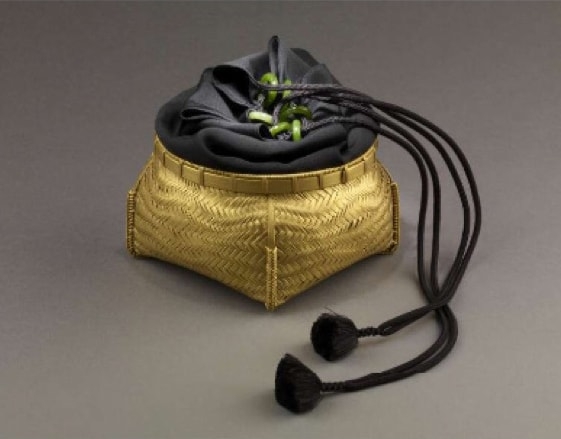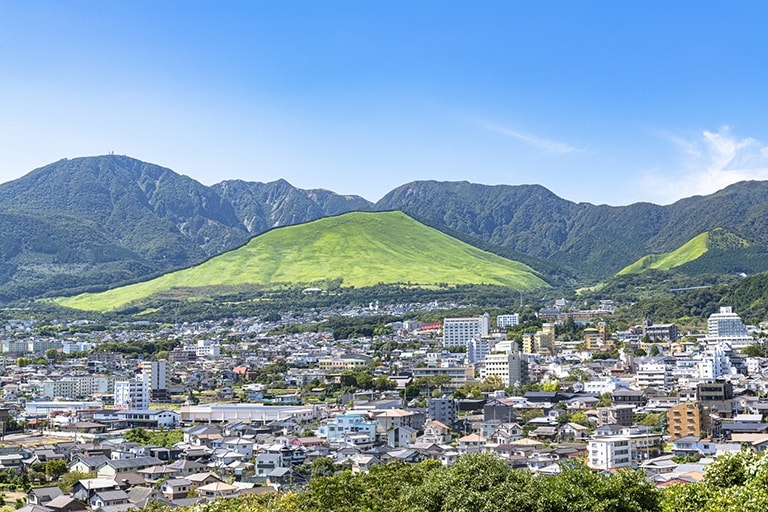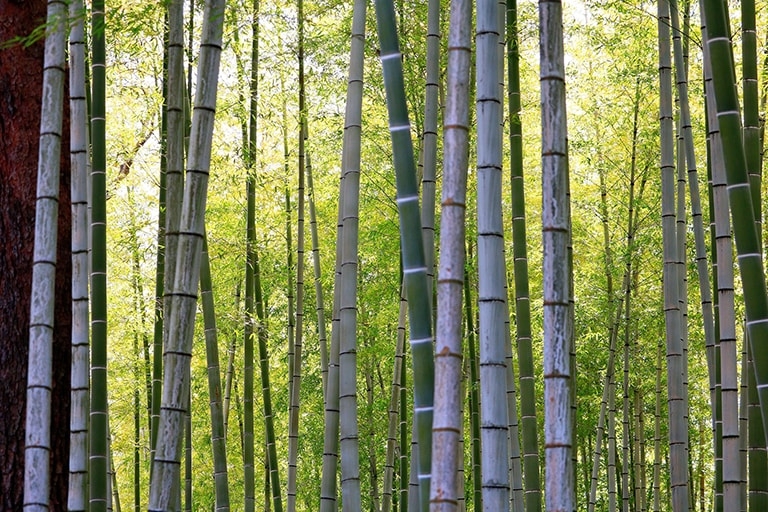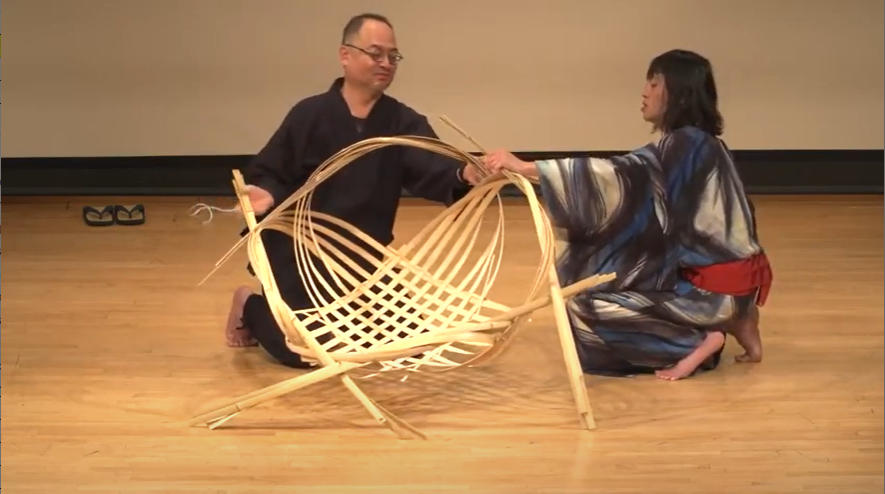Bamboo has been used in a practical sense for everyday items, but at the same time, “Bamboo can be very artistic and fashionable. As a matter of fact, three years ago, the Metropolitan Museum of Art had an exhibit of bamboo crafts.”
Before delving into the intricacies of bamboo crafts, Mr. Satouru Nakajima pointed out that the history of bamboo art in Beppu dates back 1,000 years, making it inextricably tied to Japanese history. Over time, bamboo has been used for food, in everyday life, and in architecture. And while bamboo artistry is an ancient tradition, it has been evolving into the present day, similar to “Kyoto with the advancement of the tea ceremony tradition.”
The advancement of tradition often serves in finding an appreciative audience of the craft overseas: “It is said that there are over 200 variations for weaving bamboo,” said Mr. Nakajima. “And here in NYC in 1979, there was a historic moment of convergence of bamboo art, the “bamboo party bag” by Tiffany. It is said that the Tiffany designer Elsa Peretti came up with the idea for this bag when she came to Japan and saw a bamboo bento box. It was Chikusei Watanabe, a very famous bamboo artist in Beppu, who materialized her design.”

Tiffany Co. Elsa Peretti Jade Bamboo Basket Bag, from the British Museum collection
Japan Society Talk - Functional & Alluring: Japanese Bamboo Art
Setting the scene for the art performance about to unfold, Mr. Nakajima equipped the audience with terminology and related symbolism to help them grasp the rich meaning behind the hanakago flower vase to be created on stage: “There is a Noh play called “Takasago,” and there is a line in the play that mentions oshikainami. The word “shikainami” literally means “four ocean waves,” as in the four directions are surrounded by ocean north, south, east, and west, which is true for the Japanese archipelago.” He further elaborates: “The line in the Noh play mentions this term and says that there will be peace in Japan if the waves are calm. So, this line is commonly used at weddings or other auspicious ceremonies, and the piece we are going to see today is a large version called “Oshikainami.”
At this point in the presentation, two Beppu bamboo master craftspeople appear on stage, Mr. Kenichi Otani and Ms. Takayuki Shimizu. Barefoot and dressed in traditional attire, they work swiftly and with intense purpose, with Mr. Kenichi selecting strips from the neat pile at the back of the stage, next pivoting around to hand the strips over one by one to Ms. Shimizu, who positions them strategically in a crossover woven pattern. Like a complex choreographed dance, the art comes to life gradually, born from the bamboo groves in Beppu, to reveal a completely new form in New York City.
According to Mr. Nakajima, “In bamboo weaving there are two types: the 4 by 4 and the 6 by 6. The shikainami being created on stage “is the 4 by 4 type, which creates four corners and expresses waves in the corners.” Ms. Shimizu crouches low to assemble the pattern, spacing the bamboo evenly, head down in concentration as Mr. Otani waits to hand her another strip of bamboo. As she slides the new pieces vertically under the horizontal pieces, she must first grab hold of the horizontal pieces and bend them upward to accommodate newly inserted strips of bamboo. Even this simple act of bending the strips upward demonstrates just how flexible yet sturdy the material is.
Mr. Nakajima: “This is the most fundamental way of weaving, but it’s very challenging as it requires your sensibility.” Visible to the audience is the might with which the artisans work, activating the complete use of hands and fingers to firmly grasp and pull the bamboo into place. At one point Ms. Shimizu spreads her entire hand and fingers to full width as if to correctly measure distance between the bamboo strips. The movements seem deceptively simple, almost like an afterthought, yet one has the sense that these are deliberate gestures refined over centuries and practiced for a lifetime.
Soft and flexible, yet durable
After the first batch of bamboo strips have been woven, Ms. Shimizu stands to survey the work, lifting the piece to examine it further. “They are making a vase that has a diameter of 10 centimeters, and each strip is three meters long and three centimeters wide, using a total of 16 strips,” remarks Mr. Nakajima.
All throughout this engaging performance traditional Japanese flute music accompanies the artisans as they work, a perfect complement to the weaving. It quickly becomes apparent that the task requires use of the entire body; it is not just a matter of sitting at a table and delicately working with strips of bamboo. Rather, the artists must crouch and kneel on the floor, and use their arms, hands, and elbows to position, bend, and shape the materials as they inspect each strip and reposition them into place.
Mr. Nakajima points out that “while the material itself is very soft and flexible, by weaving, the strength of the material increases and becomes very durable.”
The vase, having taken its final form, is complete. A beautiful ikebana arrangement of flowers—pink petals interspersed with green leaves and small white buds—seals the deal.
Balance between tradition and innovation
Mr. Nakajima offered a few final thoughts based on his experience as the development advisor of new bamboo artwork in Beppu City: “A few years ago, Beppu City came to me and asked me to create new bamboo works. I had no idea how I could make something greater than we already had. For example, the hanakago technique we’ve seen here today is the epitome of perfection in my eyes. But because I am not an artisan, I am able to see it from a different perspective.” He continues: “The balance between tradition and innovation is something that we can say easily with words, but how do we actually make that possible?”
Recently, when endeavoring to create a modern design, Mr. Nakajima maintained the aspect of tradition—the beautiful weaving—and intentionally incorporated a new material, acrylic, in pursuit of balance between tradition and modern. “Another point that’s very important to make is that these objects make it very easy to think about sustainability. I think it’s really beautiful to have natural objects; however, they also decay.”
The dynamic performance was followed by a short talk given by Deputy Mayor Takahashi Kawakami, who indicated the connecting thread between hot springs and bamboo: “Beppu City has always been famous for its hot springs, so people who frequented these hot springs traditionally would use bamboo-made containers to store clothing and other items. People liked the products so much they brought them back home with them.”
The Beppu bamboo tradition continues to this day.

Beppu City, Oita Prefecture



